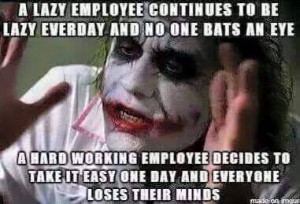How America’s Largest Retailer Walmart became its favourite punching bag
How America’s Largest Retailer Became Its Favourite Punching Bag
Martha Sellers hasn’t been able to pay her rent on time since her husband died three years ago.
She works as a cashier at Wal-Mart making $US13.40 an hour. Even after 10 years with the company, the 55-year-old says she has to borrow money every month from co-workers just to cover her utilities.
“Every month, it’s deciding on whether to pay the bills, or eat,” Sellers told Business Insider, speaking from outside the Wal-Mart where she works in Paramount, Calif., just south of Los Angeles. “There’s never enough to go all the way around.”
Sellers would love to work 40 hours a week, but she claims the company limits her hours to 35. A few months ago, a positive annual review got her a 40-cent raise, but then Wal-Mart cut her hours, she said, leaving her with less money than she had before.
“I’m one paycheck away from sleeping in my car,” Sellers continued.
While Sellers struggles to make ends meet, she hasn’t had much trouble getting attention from the press. She has described her plight to at least a dozen news organisations in the last year — including Bloomberg, the Huffington Post, the Los Angeles Times, the PBS Newshour and Al Jazeera America — emerging as something of a recurring character in what has recently become a regular Thanksgiving tradition for media outlets as predictable as the folksy chat with a Butterball tip-line operator: The eager spasm of Wal-Mart bashing that accompanies the annual build-up to Black Friday.
Often derided as the Beast of Bentonville, the mega-retailer, which did about $US466 billion in sales in the last fiscal year, has long suffered from a poor public relations profile. For decades, the company has been battered for its wages and for displacing mum-and-pop shops from local communities. As a result, even small incidents, such as the recent employee food drive at a Canton, Ohio, store for Wal-Mart “associates in need,” get national play.
Sellers owes her popularity with reporters to her association with the Organisation United for Respect at Walmart, a labour group dedicated to persuading Wal-Mart to pay its employees at least $US25,000 annually, or $US13 an hour, and to make full-time jobs available to associates who want them.
Better known by the nickname OUR Walmart, the organisation is partly funded by — and shares a mailing address with — the United Food and Commercial Workers International Union. It was launched more than two years ago following a series of unsuccessful attempts to unionize Wal-Mart’s employees. (The group’s media outreach is managed by the firm Berlin Rosen, which received nearly $US400,000 in consulting fees from the UFCW in fiscal 2012, according to documents filed with the U.S. Department of Labour.)
Although the union downplays its involvement in OUR Walmart, claiming the group is run by Wal-Mart workers, it was a UFCW employee who put Business Insider in touch with Sellers. The director of the UFCW’s Making Change at Walmart Campaign, Daniel Schlademan, serves on the executive board of Our Walmart along with another UFCW employee, according to a deposition Schlademan gave in August for a lawsuit Wal-Mart filed against the UFCW. Schlademan also said in the deposition that the UFCW provides strategy and planning advice to the group, as well as legal counsel, and manages content on the group’s website. OUR Walmart is listed as a subsidiary of the UFCW in papers filed with the U.S. Department of Labour.
Many of the features on OUR Walmart’s website were built by the Corporate Action Network, an online platform designed to help users plan protests and share strategies and documents. The brainchild of former union organiser Mark Fleischman and Brian Young, who ran Secretary of State John Kerry’s digital operations from 2007 to 2011, CAN has helped OUR Walmart plan what the group expects to be some 1,500 Black Friday actions. That said, anyone with an Internet connection can sign up to “host” a protest, regardless of his or her affiliation to Wal-Mart.
Among the materials provided to Wal-Mart protesters are tips for organising a street action, suggested chants and carols (“I Saw Walmart Kicking Santa Claus”) and a Thanksgiving Prayer that reads in part, “We ask You, oh God, to give the associates who work at this store patience and good humour as they face the busiest shopping day of the year.”
Wal-Mart downplays OUR Walmart’s influence, saying its members — who pay $US5 monthly — represent a tiny percentage of its 2.2 million associates worldwide and that the group doesn’t reflect the overall sentiment of its workers. Nonetheless, OUR Walmart has been a consistent thorn in Wal-Mart’s side, prompting the retail giant to launch a website devoted to refuting its claims.
 Diana Huffman holds a sign in support of striking Walmart workers protesting unsafe working conditions and poor wages outside a Walmart store in Pico Rivera, California, October 4, 2012.
Diana Huffman holds a sign in support of striking Walmart workers protesting unsafe working conditions and poor wages outside a Walmart store in Pico Rivera, California, October 4, 2012.Like a union, the group organizes workers and stages demonstrations, but it doesn’t engage in collective bargaining. Therefore, it is
not boundby the the National Labour Relations Act’s rules for how and when unions can picket. Members of OUR Walmart also benefit from federal labour laws that protect workers from retaliation for engaging in collective discussion and action.
Nonetheless, Wal-Mart is eager to point out the group’s association with the UFCW.
“OUR Walmart is a wholly owned subsidiary of the UFCW,” Wal-Mart spokesman Kory Lundberg told Business Insider. “They own it, they control it, they dictate what it does. There are so few current associates participating because they understand the opportunities that Wal-Mart provides.”
Business Insider reached out to the UFCW for response to Lundberg’s remarks and will update when we hear back.
In a major boost for OUR Walmart, the National Labour Relations Board recently ruled that Wal-Mart broke the law by disciplining workers (117 of them, according to OUR Walmart) who engaged in strikes on Black Friday last year. The NLRB also said Wal-Mart during two appearances on national television, Wal-Mart officials “unlawfully threatened employees with reprisal if they engaged in strikes or protests” on Black Friday.
OUR Walmart has used the board’s decision as proof that the movement for higher wages at Wal-Mart is gaining momentum. But persuading workers to strike has been challenging. And no wonder: Wal-Mart has relentlessly fought back against organising drives, even going so far as to shutter a store in Canada after employees voted to unionize.
OUR Walmart says roughly 400 workers went on strike on Black Friday last year. Wal-Mart disputes that figure.
“What we saw was a little more than 100 associates out the 1.3 million in the U.S. participating in the protests,” Lundberg said, referring to last year’s Black Friday actions. “Some called out of work and some worked their shift. Others weren’t even scheduled to work that day.”
Even the higher figure represents less than .05% of Wal-Mart’s U.S. workforce, which is not likely to disrupt the chain’s operations. “If history is any indication as to what this group says it is going to do, and what they pull off, then we’re expecting to have another great Black Friday,” Lundberg said.
“Great” might be an overstatement, although the major challenge to the retailer will likely be the sluggish economy. Wal-Mart is expecting flat sales as retailers brace for the weakest holiday shopping quarter since 2009, which is one reason why the company decided to start its Black Friday sales online a week early and open stores at 6 p.m. on Thanksgiving.
Worker actions began early this year as well. Rafael Martinez, who is supporting a family of four on a wage of $US9.50 per hour, walked off the job at his Miami Wal-Mart on Monday and participated in a protest outside the store with about 20 other workers. He said he’s planning to strike again on Black Friday.
“I’m afraid of losing my job,” Martinez told Business Insider by phone from from the picket line outside the store. “But we have the right to express our opinion.”
“We ask You, oh God, to give the associates who work at this store patience and good humour as they face the busiest shopping day of the year.”
Katie Cunningham, 63, was also striking in Miami on Monday. She said she supplements her $US8.75-per-hour salary with help from her three grown daughters. “I am just hoping [Wal-Mart doesn’t] fire me,” she said. “I need the money.” Asked whether she plans to participate in the Black Friday protests — when she is on the schedule to work — Cunningham said it would depend on the protest organisers at OUR Walmart. “If they tell me to, I will,” she vowed.
Cunningham said she joined OUR Walmart about 18 months ago, more than a year after she started working at Wal-Mart. She heard about the group from a co-worker and began attending meetings, which are held on the third Wednesday of every month, often in a meeting room at a local motel, and include presentations by labour organisers.
“They are teaching me a lot,” Cunningham said. “There’s a lot that I didn’t know about Wal-Mart. There is so much that they are not telling us.”
‘Modern-Day Pharaohs’
If any company can afford to give its employees a raise, Wal-Mart can. While the average wage of Wal-Mart associates is the subject of some dispute (OUR Walmart claims that most make less than $US9 per hour, an estimate based on data from IBISWorld and Glassdoor.com, while Wal-Mart pegs the figure at $US11.83), there’s little doubt that many of the store’s workers are stuck below the poverty line, currently $US23,550 for a family of four.
 Jim Walton, Alice Walton, and Rob Walton cheer at the annual shareholders meeting for Walmart in Fayetteville, Arkansas.
Jim Walton, Alice Walton, and Rob Walton cheer at the annual shareholders meeting for Walmart in Fayetteville, Arkansas.By contrast, the Waltons are doing quite well. Forbes estimates that the net worth of just six of their family members tops $US144 billion, a figure greater than New Zealand’s entire economy. The family’s 50.9% stake in the company, valued at $US131 billion, paid out a hefty $US2.5 billion in dividends last year (enough, as OUR Walmart points out, to give every one of the retailer’s 1.3 million U.S. employees nearly $US2,000 in cash).
The Waltons have mostly kept their multi-billion-dollar lifestyles out of the public view, and for good reason. Images of private jets, vintage racing cars and sprawling properties don’t mesh well with those stories about Wal-Mart workers being unable to afford Thanksgiving dinner.
They are “modern day Pharaohs right out of the book of Exodus,” Rev. Holly Beaumont, who is helping to organise Wal-Mart protests in New Mexico, said of the Waltons. “They are accumulating wealth at obscene proportions without [any concern for] their workers, forcing them to depend on the charity of their community.”
A study by congressional Democrats suggested that low wages at a single Wal-Mart could be costing taxpayers as much as $US900,000 per year, due to employees using programs like food stamps and Medicaid. “When low wages leave Walmart workers unable to afford the necessities of life, taxpayers pick up the tab,” the report said. Even those government payments wind up boosting Wal-Mart’s bottom line. The company itself estimates that about 18% of the the nation’s food stamps are spent in its stores.
Charity
“The Walton family promotes the overall quality of life and financial independence of future generations,” notes a a promotional video touting the family’s philanthropic endeavours through the Walton Family Foundation. The question some are asking is: ‘Whose quality of life?’
The family’s main charitable arm gave out $US432 million in 2012, according to the foundation’s website, much of it dedicated to education reform (a movement that is also anathema to many labour unions) and freshwater and marine conservation, or as the Foundation calls it “conservationomics” — environmental protection geared toward boosting local economies.
One of the Waltons’ newest charitable projects is directed by Alice Walton, the daughter of Wal-Mart founder Sam Walton. Crystal Bridges Museum of American Art in Bentonville, Ark., is backed by a dizzying $US1 billion in donations from the Walton family. The the museum’s collection includes paintings by Jackson Pollock, Winslow Homer, Robert Rauschenberg and Georgia O’Keeffe.
Designed by Israeli-born Boston architect Moshe Safdie, the museum is set on 120 acres in a wooded area next to the home where the Walton children grew up and a couple miles from the Wal-Mart headquarters. It’s a two-hour drive from the nearest airport in a town with a population of less than 40,000.
While visitor reviews of the museum, which offers free admission to the main collection, are overwhelmingly positive, a Bloomberg report in September suggested that the institution yields dividends to the Waltons that go beyond simple altruism. As it turns out, the Walton Family Foundation, which pays for the museum, is funded by a collection of 21 trusts that help the Waltons to avoid estate and gift taxes. Tax attorney and former law professor Jerome Hesch told Business Insider that the Waltons “manipulate the trusts considerably,” using them as vehicles to pass money onto their heirs tax-free.
Here’s how it works: The trusts are set up to give a set amount to charity annually over the course of 20 to 30 years. If the trusts outperform a benchmark rate of return tied to U.S. Treasury bond yields — a number that was determined at the time the trust was set up — then the extra earnings go to designated heirs.
Sam Walton’s wife, Helen Walton, picked an opportune moment to set up four of the trusts, when the benchmark rate was 3.6%. According to Bloomberg’s analysis of IRS filings, the trusts returned a 14% rate of return between 2007 and 2011.
“That growth means the four Helen Walton trusts have been accumulating assets faster than they give them away,” Bloomberg’s Zachary R. Mider reported. “As of 2011, they held a combined $US2 billion, up from $US1.4 billion in 2007. Barring a stark reversal of fortune, at least that much money will probably pass to Helen Walton’s heirs.”
Planning Black Friday
While Wal-Mart says the effect of the Black Friday strikes will be insignificant, OUR Walmart claims momentum is building in the fight for higher wages and that regardless of how many workers strike, there will be hundreds of community supporters attending protests Friday at store locations across the U.S. At the very least, it will keep the retailer’s communications team working overtime playing defence throughout the holiday season.
Dozens of labour groups, as well as groups like Occupy Wall Street and its affiliates, are rallying behind the cause. Richard Trumka, president of the AFL-CIO, has said that 13 million members of the AFL-CIO will “stand in lockstep with the Walmart workers along their path to justice.”
Rev. Walter P. Turner III, Pastor of New Spiritual Light Church in Chicago, said the local religious community is also backing the protests. Chicago clergy originally welcomed the arrival of Wal-Mart stores into their communities because they believed the retailer would provide much-needed jobs, Turner acknowledged. “But when we began to hear about the level of disrespect, by the way of wages that are totally below poverty level, we began to feel that this was a moral issue that we needed to take a stand on,” he said.
“It is not right for someone to work this many hours and still make $US15,000 [a year],” he added.
Most protests will start around noon in Wal-Mart parking lots on Black Friday. The protest instructions provided by the Corporate Action Network direct a delegation of people to enter the store at some point to ask to speak to the manager. They will tell the manager that they are protesting for higher wages and hand them a letter stating their goals, after which they are supposed to exit the stores to resume demonstrating outside.
The weather is expected to be between 20 degrees and 30 degrees Fahrenheit in the Northeast and Midwest, not unpleasant enough to deter protesters, or shoppers.
The protest at Martha Sellers’ store in Paramount, Calif., is set to get underway at 11:30 a.m. She’ll be there, she said, but only until her shift begins later that day. She claims she’s getting involved in protests not just for fellow associates, but also for the legacy of Wal-Mart’s founder. “Sam has a quote where he says, ‘I hope my descendants never become part of the idle rich,’” Sellers said. “Well that’s exactly what they’ve done. This is his legacy that they are destroying and they just continue to ignore us. They would rather race their cars and build their art galleries than take care of their associates.”
Meanwhile, this shopping season will be the swansong for Wal-Mart President and CEO Mike Duke, who announced on Monday he is stepping down at the end of the year to be replaced by Doug McMillon, the chief executive of Wal-Mart International. The company’s new leader is just 47, but he’s got plenty of experience: He started at Wal-Mart in 1984, as a lowly associate.







![Wal-Mart Means America [infographic]](http://ihateworkinginretail.ooid.com/wp-content/uploads/2014/04/WeightofWalmart-150x150.jpg)





















Recent Comments